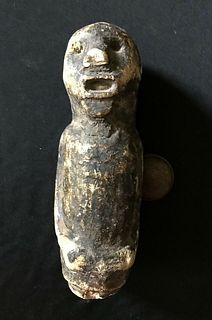Published Egyptian Stone Panel Ramesses III Cartouche
Lot 9
About Seller
Artemis Fine Arts
686 S Taylor Ave, Ste 106
Louisville, CO 80027
United States
Selling antiquities, ancient and ethnographic art online since 1993, Artemis Gallery specializes in Classical Antiquities (Egyptian, Greek, Roman, Near Eastern), Asian, Pre-Columbian, African / Tribal / Oceanographic art. Our extensive inventory includes pottery, stone, metal, wood, glass and textil...Read more
Categories
Estimate:
$20,000 - $28,000
Absentee vs Live bid
Two ways to bid:
- Leave a max absentee bid and the platform will bid on your behalf up to your maximum bid during the live auction.
- Bid live during the auction and your bids will be submitted real-time to the auctioneer.
Bid Increments
| Price | Bid Increment |
|---|---|
| $0 | $25 |
| $300 | $50 |
| $1,000 | $100 |
| $2,000 | $250 |
| $5,000 | $500 |
| $10,000 | $1,000 |
| $20,000 | $2,500 |
| $50,000 | $5,000 |
| $100,000 | $10,000 |
| $200,000 | $20,000 |
About Auction
By Artemis Fine Arts
Feb 13, 2020
Set Reminder
2020-02-13 10:00:00
2020-02-13 10:00:00
America/New_York
Bidsquare
Bidsquare : Exceptional Antiquities, Asian, Ethnographic
https://www.bidsquare.com/auctions/artemis-gallery/exceptional-antiquities-asian-ethnographic-4848
An important one-day auction featuring museum-worthy examples of Egyptian, Greek, Roman, Etruscan, Near Eastern, Far East / Asian, Pre-Columbian, African / Tribal, Oceanic, Native American, Spanish Colonial, Russian, Fossils, Ancient Jewelry, Fine Art, so much more! Artemis Fine Arts info@artemisgallery.com
An important one-day auction featuring museum-worthy examples of Egyptian, Greek, Roman, Etruscan, Near Eastern, Far East / Asian, Pre-Columbian, African / Tribal, Oceanic, Native American, Spanish Colonial, Russian, Fossils, Ancient Jewelry, Fine Art, so much more! Artemis Fine Arts info@artemisgallery.com
- Lot Description
Ancient Egypt, New Kingdom, 20th Dynasty, reign of Ramesses III, ca. 1186 to 1155 BCE. A stunning limestone panel that is expertly etched on one side with the enclosed cartouche of the second pharaoh of the Twentieth Dynasty: Ramesses III. The cartouche is presented sideways within an ovoid framework - representing a length of rope with a tied knot on one side - and is read from right to left. The carved hieroglyphic symbols depict the falcon-headed god Ra seated beneath a sun disc, a trio of fox-skins, two folded cloths, a sedge plant, a crook, and a pillar that, when translated, read, "Ramesses Heqa Iunu" (Ramesses, King of Heliopolis). Ramesses III is known as the last New Kingdom pharaoh to rule with authority, and his nickname of "warrior king" stemmed from his reputation as an aggressive and highly refined military tactician. Size: 17.125" W x 10.7" H (43.5 cm x 27.2 cm); 13.4" H (34 cm) on included custom stand.
Ramesses III (full name: Usermaatre-Meryamun Ramesses Heqa Iunu, meaning "The Ma'at of Ra is strong, Beloved of Amun, Born of Ra, Ruler of Heliopolis") is one of the most influential and authoritative pharaohs in ancient Egypt and is considered to be the last powerful king of the New Kingdom period. He is considered to be one of the New Kingdom's greatest visionaries and builders, however his success was overshadowed by the economic turmoil, constant invasions, and international conflicts left unsettled by his father, King Setnakht, and his grandfather, King Merenptah. According to Egyptologists Erik Hornung and Betsy M. Bryan, "After Merenptah the dynasty ended in relative chaos due to further foreign pressures in the north, east, and west, and it took some time for the country to reorganize itself under Setnakht, the first king of the Twentieth Dynasty. But it is really his son, Ramesses III . . . who protected Egypt from the Libyans' intrusions in the western Delta and from the Sea Peoples, whom he destroyed in year 8 in a major land and sea battle represented in great detail on the walls of his memorial temple at Medinet Habu." (Hornung, Erik and Betsy M. Bryan, eds. "The Quest for Immortality: Treasures of Ancient Egypt." National Gallery of Art, Washington, 2007, p. 21).
Published in: Ede, Charles. "Writing and Lettering in Antiquity." Charles Ede, Ltd. London, 1974, entry no. 17.
Provenance: ex-private Stephenson collection, Greenwich, Connecticut, USA, acquired from Charles Ede Gallery in October 1986, London, England; published in "Writing and Lettering in Antiquity," 1974, entry no. 17
All items legal to buy/sell under U.S. Statute covering cultural patrimony Code 2600, CHAPTER 14, and are guaranteed to be as described or your money back.
A Certificate of Authenticity will accompany all winning bids.
We ship worldwide and handle all shipping in-house for your convenience.
#151707Chips and nicks to cartouche border, inscribed hieroglyphs, and peripheries, with light encrustations, and minor softening to some finer details on hieroglyphs, otherwise intact and excellent. Light earthen deposits throughout. Hieroglyphs are still visible and legible.Condition
- Shipping Info
-
All shipping is handled in-house for your convenience. Your invoice from Artemis Gallery will include shipping calculation instructions. If in doubt, please inquire BEFORE bidding for estimated shipping costs for individual items.
-
- Buyer's Premium



 EUR
EUR CAD
CAD AUD
AUD GBP
GBP MXN
MXN HKD
HKD CNY
CNY MYR
MYR SEK
SEK SGD
SGD CHF
CHF THB
THB















